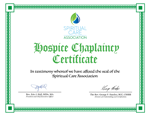Earn Your Hospice Chaplaincy Certificate

Foundations of Hospice Chaplaincy
Course Author: The Rev. Sue Wintz, M.Div., BCC
Self Guided
This course, Foundations of Hospice Chaplaincy is designed for those interested in the specialized work as a chaplain within a hospice team. Its purpose is to empower learners with the basic skills and knowledge needed in order to provide care to persons and families who are admitted to hospice as well as to contribute effectively as a member of the hospice interdisciplinary team.
About the Course:
The Foundations of Hospice Chaplaincy Certificate Course is a self-guided course. You can complete the work online at your own leisure. You will have up to 6 months to complete the course.
By the end of this course the learner will be able to:
- Explain the differences between chaplaincy care, spiritual care, and pastoral care.
- Articulate the academic and training requirements required of board certified chaplains.
- Discuss the processes of board certification and chaplain credentialing.
- Identify the importance of a professional chaplain’s code of ethics and its impact upon practice.
- Describe the history of hospice and its unique philosophy.
- Explain the role of the hospice interdisciplinary team.
- Describe the elements of spirituality, religion, existential beliefs, spiritual-but-not-religious, and those who identify as “nones”.
- Articulate the benefits of spirituality and spiritual well-being.
- Explain spiritual distress and how it is manifested and measured.
- Define cultural competency and cultural humility as it is applied in hospice chaplaincy.
- Describe and apply the major concepts of communication with diverse cultures.
- Articulate and apply a plan to develop collaborative relationships with community cultural, spiritual, and religious leaders.
- Identify methods to obtain and employ knowledge of common beliefs and practices of unfamiliar cultures, religious/spiritual beliefs, or existential norms.
- Distinguish methods by which to identify vulnerable populations that are part of one’s chaplaincy setting population cache in order to evaluate gaps in the provision of spiritual care.
- Describe the importance of identifying the unique spiritual/cultural/religious beliefs within vulnerable patient populations (including immigrants and refugees, LGBTQ, homeless, incarcerated, low health literacy/illiterate, mentally-challenged severely disabled).
- Understand ways to assess, document, and include in a care plan appropriate spiritual/religious interventions for cross-cultural situations.
- Summarize varying cultural practices relating to the end of life and the chaplain’s role in supporting persons, families, and the hospice team.
- Explain effective listening habits and skills and a systematic method of listening behavior.
- Identify the principles of effective group communication and various roles and norms in a group communication process.
- Demonstrate an understanding of family systems theory.
- Identify best practices in providing support to hospice families.
- Recognize and understand the physiological changes that occur during the dying process.
- Identify the issues of emotional and spiritual distress that are experienced by persons facing the end of life, articulate appropriate interventions and demonstrate their application.
- Understand the conflicts that can occur between the dying person, family/family of choice, and associated communities and articulate appropriate interventions.
- Articulate the role of spiritual, religious or existential support, practices, and cultural norms in coping, dying and after death care of the body.
- Define and differentiate the following concepts: grief, mourning, bereavement, anticipatory grief, complicated grief, disenfranchised grief and the impact of each on spiritual, emotional, and/or existential issues and chaplaincy care.
- Describe the process of grief noting manifestations of grief, the typical courses or pathways of grief, and signs that grief may be more complicated.
- Discuss current theories of grief including Worden’s Task Model, The Dual Process Model, and Meaning Reconstruction.
- Demonstrate sensitivities to the varied losses persons may experience such as the loss of a parent, spouse/partner, child, or sibling, as well as losses that may be disenfranchised by the larger community.
- Define the concepts of medical futility and palliative sedation.
- Recognize the distinctive aspects of chaplaincy and spiritual care in working with children and their families.
- Distinguish the most common spiritual issues involved in pediatric chaplaincy and spiritual care, including how to screen and assess for them.
- Discuss appropriate interventions to meet the spiritual, religious, cultural, and communication needs of families of pediatric patients.
- Articulate the major ethical issues that arise in pediatric end of life situations including hospice and palliative care.
- Define compassion fatigue, burnout, and moral distress including their symptoms.
- Define emotional resilience and its components.
- Describe Critical Incident Debriefing as a tool for reduction of stress.
Course Outline
- Chaplaincy and Hospice
- Spirituality, Religion, Existential Beliefs, and “Nones”
- Cultural Competence and Vulnerable Populations in Hospice
- Communication Skills and Care for Families
- Spiritual Assessment and Documentation
- Dying, Death, and Grief
- Ethics and its role in Hospice
- Pediatrics
- Caring for the Hospice Team
Number of Continuing Education Hours: 35
Credit towards Board Certification Requirements: 1
Aligns with the following Quality Indicators in What is Quality Spiritual Care in Health Care and How Do You Measure It? (HCCN. 2016).
- Structural Indicator 1.A. Chaplains as certified or credentialed spiritual care professional(s) are provided proportionate to the size and complexity of the unit served and officially recognized as integrated/embedded members of the clinical staff.
- Structural Indicator 1.C. Information is provided about the availability of spiritual care services.
- Structural Indicator 1.D. Professional education and development programs in spiritual care are provided for all disciplines on the team to improve their provision of generalist spiritual care.
- Structural Indicator 1.E. Spiritual care quality measures are reported regularly as part of the organization’s overall quality program and are used to improve practice.
- Process Indicator 2.A. Specialist spiritual care is made available within a time frame appropriate to the nature of the referral.
- Process Indicator 2.B. All clients are offered the opportunity to have a discussion of religious/spiritual concerns.
- Process Indicator 2.C. An assessment of religious, spiritual, and existential concerns using a structured instrument is developed and documented, and the information obtained from the assessment is integrated into the overall care plan.
- Process Indicator 2.D. Spiritual, religious, cultural practices are facilitated for clients, the people important to them, and staff.
- Process Indicator 2.E. Families are offered the opportunity to discuss spiritual issues during goals of care conferences.
- Process Indicator 2.F. Spiritual care is provided in a culturally and linguistically appropriate manner.4 Clients’ values and beliefs are integrated into plans of care.
- Process Indicator 2.G. End of Life and Bereavement Care is provided as appropriate to the population served.
Questions?

Charles James Parker, MDiv, EdD, APBCC-HPC
Director of Hospice and Palliative Care Division
T: (757) 751-0273
cparker@spiritualcareassociation.org
